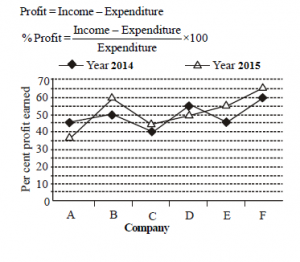Hello Aspirants,
Welcome to Online Quant Section in AffairsCloud.com. We are starting IBPS Clerk course 2015 and we are creating sample questions in Quantitative Aptitude section, type of which will be asked in IBPS Clerk Main Exam.
Stratus – IBPS Clerk Course 2015

[flipclock]
- Two varieties of rice costing Rs 280 per kg and Rs 180 per kg respectively are mixed in certain ratio to form mixtures A and B. Now A and B are mixed in the ratio 1 : 2 to form mixture C which is sold at Rs 288 per kg at 20% profit. If A costs Rs 200 per kg, in what ratio were the original varieties mixed to form mixture B?
A) 5 : 3
B) 3 : 2
C) 4 : 1
D) 6 : 5
E) None of theseC) 4 : 1
Explanation:
CP of mixture C = [100/(100+20)] * 288 = Rs 240
Let CP of mixture B is x
By method of allegation:
A(1) B(2)
200 x
. 240
(x-240) 40
Then, (x-240)/(40) = 1/2
Solve, x = 260
So CP of B is 260 per kg
Now again by method of allegation:
From both original varieties B is formed in ratio:-
Variety 1 Variety 2
280 180
. 260
(260-180) (280-260)
80 : 20 = 4 : 1 - A product is passed through three stages A, B, and C which remove 60%, 50% and 20% of the impurities from the product. After the three stages the product contained 4800 units of impurities. What was the amount of impurities originally present in the product before it was passed for test?
A) 20,000 units
B) 25,000 units
C) 30,000 units
D) 24,000 units
E) None of theseC) 30,000 units
Explanation:
Let x units of impurities present initially
After A stage, 60% impurities removed, so 40% remained
After B stage, 50% impurities removed, so 50% remained. And after C stage, 20% impurities removed, so 80% remained.
So x*(40/100)*(50/100)*(80/100) = 4800
Solve, x = 30,000 - On purchasing 100 TVs, one gets a discount of 25%. The person sells these and makes a profit equal to the undiscounted price of 25 TVs. What is the profit percentage?
A) 25%
B) 30%
C) 33.33%
D) 66.66%
E) 75%C) 33.33%
Explanation:
Let CP of 1 TV = Re 1, then CP of 100 = Rs 100
But after discount, person gets them for (75/100)*100 = Rs 75
Now on selling these he gets profit of Rs 25 [Rs 25 is the undiscounted price of 25 TVs]
This means SP = 75+25 = 100
Profit% = [(100-75)/75] * 100 - 40 men who can complete a job in 96 days started the work. After 24 days, 20 more men joined. After 32 more days, x men left. The remaining men completed the work in 20 more days. What is the value of x?
A) 12
B) 9
C) 14
D) 16
E) 10A) 12
Explanation:
40 men complete work in 96 days. So 60 men in (40*96)/60 = 64 days
40 men worked for 20 days, after this (40+20) = 60 men worked for 32 days, after this (60-x) men completed the work in 20 more days.
Let these (60-x) men completes 1 work in y days.
So (1/96)*24 + (1/64)*32 + (1/y)*20 = 1
Solve, y = 80
This means (60-x) men complete 1 work in 80 days
M1*D1 = M2*D2
40*96 = (60-x)*80
Solve, x = 12 - The length and the breadth of a room is 15m and 12 m respectively. The sum of the areas of the floor and the ceiling is equal to the sum of the areas of the four walls. Find the volume of this room.
A) 1350 m3
B) 1200 m3
C) 1050 m3
D) 1250 m3
E) 900 m3B) 1200 m3
Explanation:
Let h be the height of room, then
15*12 + 15*12 = 15*h + 15*h + 12*h + 12*h
Solve, h = 20/3 m
Then volume = 15*12*(20/3)
Directions (6-10): Study the following graph carefully and answer the questions given below:
The graph shows the profit percent earned by 6 companies during 2014 and 2015. 
- If the income of company C in the year 2014 was 35 lacs, what was its expenditure in that year?
A) 24 lacs
B) 21 lacs
C) 22 lacs
D) 20 lacs
E) 25 lacsE) 25 lacs
Explanation:
In 2014, profit of company C is 40%
So 40 = [(35 lacs – exp.)/exp.] * 100 - If in the year 2015, total expenditure of companies B and C was 48 lacs, then what was their total income in the same year?
A) 28.6 lacs
B) 42 lacs
C) 28 lacs
D) Cannot be determined
E) None of theseD) Cannot be determined
Explanation:
We need to know the individual expenditures to find the individual incomes. The formula does not apply to sum of incomes or sum of expenditures. - The income of Company D in the year 2014 was 31 lacs. What was the earned profit?
A) 20 lacs
B) 11 lacs
C) 17 lacs
D) 12 lacs
E) 15 lacsB) 11 lacs
Explanation:
In 2014, profit% of D is 55%
So 55 = [(31 lacs – exp.)/exp.] * 100
Expenditure = 20 lacs
So profit = 31-20 = 11 lacs - If the expenditures of Company E in the years 2014 and 2015 were the same, what was the ratio of the incomes of the company in the same years respectively?
A) 29 : 33
B) 11 : 21
C) 19 : 21
D) 29 : 31
E) 9 : 11D) 29 : 31
Explanation:
Let exp. of E in 2014 and 2015 is x
Then, 45 = [(income – x)/x] * 100
Solve, so income of E in 2014 is 29x/20
Also, 55 = [(income – x)/x] * 100
Solve, so income of E in 2015 is 31x/20
So ratio = 29x/20 : 31x/20 = 29 : 31 - If the income of company F in the year 2014 was 40 lacs, what was its expenditure in that year?
A) 27 lacs
B) 32 lacs
C) 25 lacs
D) 30 lacs
E) 35 lacsC) 25 lacs
Explanation:
In 2014, profit% of F is 60%. So
60 = [(40 lacs – exp.)/exp.] * 100
AffairsCloud Recommends Oliveboard Mock Test
AffairsCloud Ebook - Support Us to Grow
Govt Jobs by Category
Bank Jobs Notification


